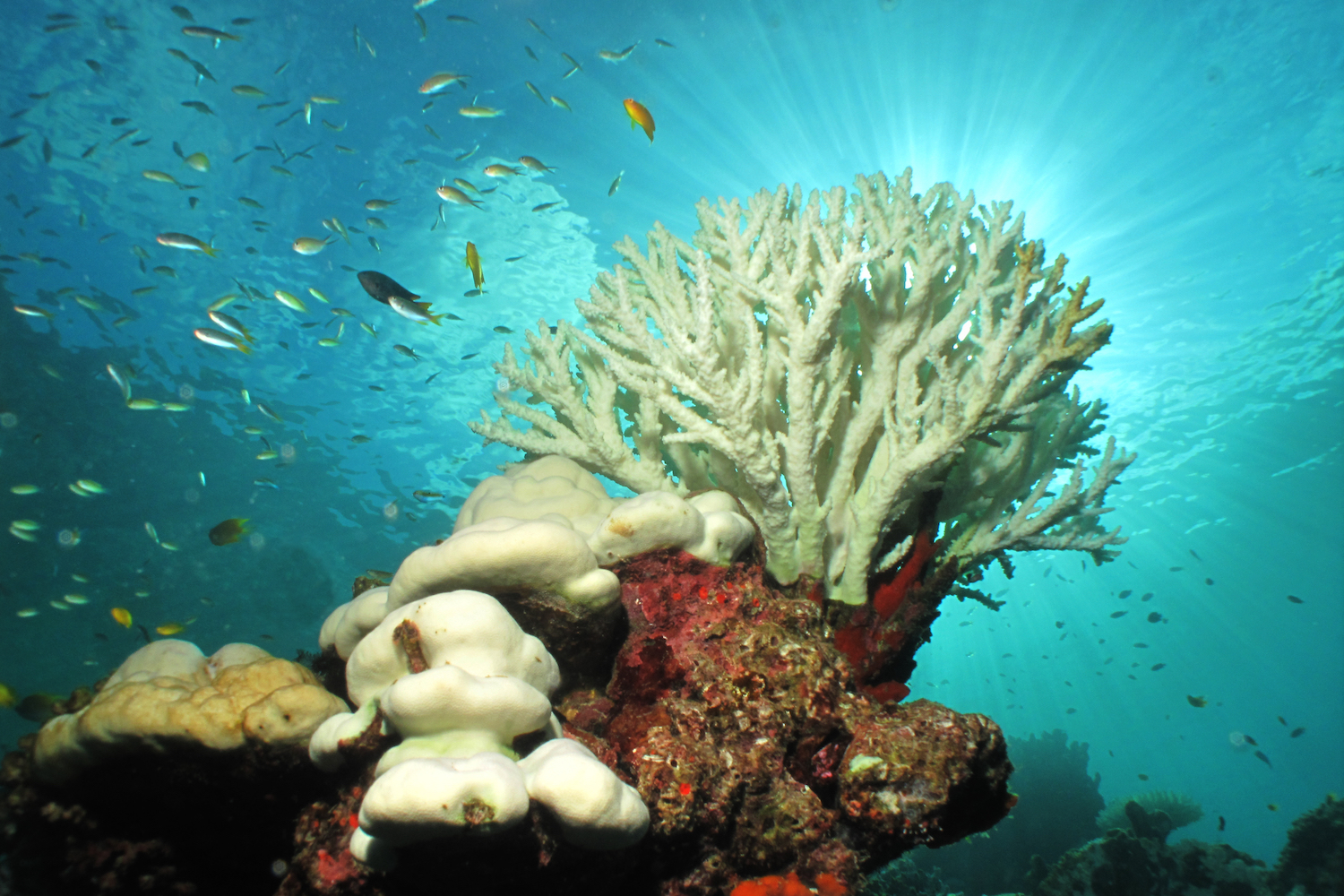What Is Coral Bleaching?
Once vibrantly colored and teeming with life, many coral reefs around the planet are now bleached and barren, thanks to a condition called coral bleaching. Their color drained, bleached reefs stand like skeletons along the world's coastlines, from Australia and Madagascar to the Persian Gulf and the Caribbean Sea.
But coral bleaching is much more than an aesthetic loss. It is an environmental indicator: an omen of starving animals, a failing ocean ecosystem and a devastating change in global climate. Rising ocean temperatures are the fundamental cause. But before we can understand why these beautiful coral ecosystems are now at risk, we have to understand how they got their radiant color in the first place.
How do corals get their color?
Coral reefs are made up of polyps, small, colorless animals that have a sac-like body with a mouth-like opening and a crown of stinging tentacles. A coral reef consists of many individual polyps functioning together as one unit.
The polyps themselves are transparent. Coral reefs get their color from the tiny creatures living inside the polyps: algae called zooxanthellae.
Coral and zooxanthellae enjoy a mutually beneficial partnership, known as symbiosis. Coral provides the algae with shelter, access to sunlight and other resources needed for photosynthesis. The algae, in turn, share the nutrients produced by photosynthesis with the coral. As much as 90 percent of the nutrients that algae produce are transferred to their coral hosts, according to the National Oceanic and Atmospheric Administration (NOAA).
Why do corals bleach?
Under environmental stress, the intricate algae-coral partnership becomes unhinged. Factors such as temperature changes, pollution and overfishing can destabilize the relationship and cause the coral to expel the algae. Once the algae are gone, the coral's bright white calcium-carbonate exoskeleton is visible through its transparent tissue, hence the name coral bleaching.
Rising sea temperatures brought on by global warming have become the greatest danger to coral reefs, according to NOAA. Temperature spikes of only 1.8 to 3.6 degrees Fahrenheit (1-2 degrees Celsius) can trigger mass bleaching events that affect tens to hundreds of miles of coral reef. This type of heat stress affected 70 percent of the world's coral reefs between 2014 and 2017.
Get the world’s most fascinating discoveries delivered straight to your inbox.
Coral bleaching happens gradually, said Ruben Torres, a marine scientist and the founder of Reef Check Dominican Republic, a nonprofit ocean-conservation group. As water temperature rises above the coral's comfort zone, the algae begin to leave, and the coral grows paler until all of the algae are gone.
"Once algae are gone, they [the corals] lose their source of energy," Torres said. "They are basically starving to death."
Bleached coral are still alive, but without the algae, the coral are vulnerable. They have less energy and are more prone to disease. If the water temperature remains high for days or weeks, according to NOAA, bleached coral will begin to die. If the water temperature goes back to normal, the coral can eventually regain algae and their color, but even the fastest growing corals need 10 to 15 years to fully recover, according to a 2013 study published in the journal Science.
"We used to think bleaching happened once a century," said Dave Vaughan, a biologist at the Elizabeth Moore International Center for Coral Reef Research & Restoration in Florida. "Corals would have 100 years to recuperate," he said. "But then, there was one bleaching in the '70s, two in the '80s and now 12 in the last 14 years."
The rise in coral bleaching parallels increases in atmospheric and ocean temperatures. Between 2016 and 2017 — the two hottest years on record, according to NASA — half of the Great Barrier Reef died in bleaching events set off by high sea temperatures, a study published in 2018 in the journal Nature reported. [Image Gallery: Great Barrier Reef Through Time]
A sliver of hope
The outlook for corals is grim but not completely hopeless. Natural reefs will not last through the 21st century if climate change continues undeterred, according a 2017 United Nations assessment. Because plans for lowering global carbon dioxide emissions are not taking effect at a rate fast enough to save reefs, some scientists are going a step further to preserve coral communities by giving them a boost.
Vaughan and his colleagues explore coral reefs that have experienced bleaching to find the survivors. The researchers then raise those particular corals in the lab to better understand what makes them more resilient. Vaughan said he hopes to grow coral that can withstand today's conditions — and tomorrow's warmer conditions — and then plant them on natural reefs to make the reefs hardier.
"Some corals aren't affected or bounce back faster so they don't get disease or starve to death," Vaughan said. "If we make more of those, we make a more resilient reef."
Other researchers are busy crossbreeding different strains of resistant corals to develop what are known as supercorals, which have an even better chance at surviving climate change. Both types of resilient coral have been grown in nurseries and planted back in the ocean successfully, but only on an experimental level. Now, scientists are aiming to plant at a much larger scale, Vaughan said. Reef restoration is desperately needed all over the world, but it won't come cheap, he said.
The first few years of growing and planting coral have a high cost and a low output. It can cost $25 to $200 to grow and plant a single coral, Vaughan said. A reef the size of a football field contains upward of 10,000 individual corals; that's $2 million to restore a small reef.
After four to five years, however, production increases and the price per coral falls. Today, Vaughan's lab grows and plants each coral for $10, and he said, at scale, that number could fall to $2 per coral, each critter costing the same as a cup of coffee.
So, what's the cost of restoring the world's reefs? Vaughan has run the numbers (it's in the billions), but he said the better question is, "What's the cost if we don't?"
Are coral reefs really worth the trouble?
No matter how much these rescue attempts cost, marine biologists argue that saving coral reefs is essential, for both biological and economic reasons.
Coral reefs cover only 1 percent of the ocean floor, but the Smithsonian estimates that as much as 25 percent of marine life depends on these reefs for food and shelter. In other words, coral reefs make up the backbone of the ocean's most diverse ecosystem. So, although the term "coral bleaching" refers to a phenomenon affecting just one group of closely related species, their deaths devastate an entire habitat.
Humans also have a huge stake in healthy coral reefs. Reef-related tourism is worth $35 billion to the global economy, according to a 2017 study published in the journal Marine Policy.
Reefs also help to protect shorelines, especially with today's increasingly severe tropical storms, preventing as much as $4 billion in flood damages globally every year, according to a recent study in the journal Nature Communications. The demise of these reefs, via bleaching and collapse, would cost the U.S. $100 million a year in additional flood damages, the same study concluded. Countries like Indonesia and the Philippines would be hit even harder, incurring annual damages of more than $600 million.
Saving coral reefs is daunting, but the alternative is cataclysmic, Vaughan said. He's set his sights on planting 1 million corals before he retires. He's planted TKHOWMANY so far. Starting in January 2019, he's taking his reef-restoration efforts global through his Plant a Million Corals effort, in which he travels the world educating and consulting clients on how to restore the reefs near them. As Vaughan sees it, "There is hope."
Further reading:
- See these shocking images from the Coral Reef Image Bank of the devastating effects of coral bleaching.
- Read more about coral bleaching on the Great Barrier Reef, from the Australian Marine Conservation Society.
- Find an overview of the basic biology of coral reefs here from the Scripps Institution of Oceanography.

Donavyn Coffey is a Kentucky-based health and environment journalist reporting on healthcare, food systems and anything you can CRISPR. Her work has appeared in Scientific American, Wired UK, Popular Science and Youth Today, among others. Donavyn was a Fulbright Fellow to Denmark where she studied molecular nutrition and food policy. She holds a bachelor's degree in biotechnology from the University of Kentucky and master's degrees in food technology from Aarhus University and journalism from New York University.




